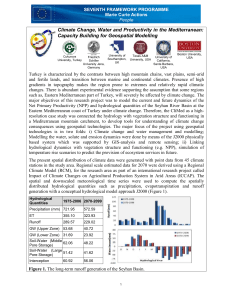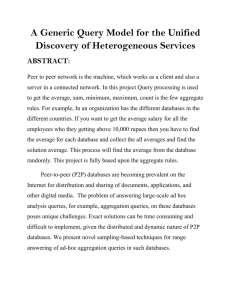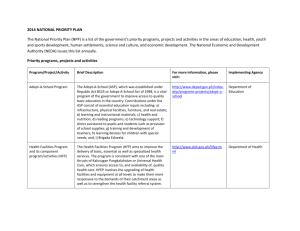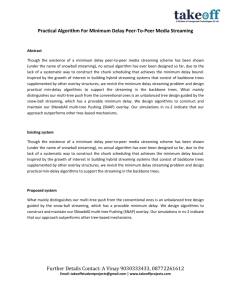ISP-Friendly P2P Streaming - Oregon Network Research Group
advertisement
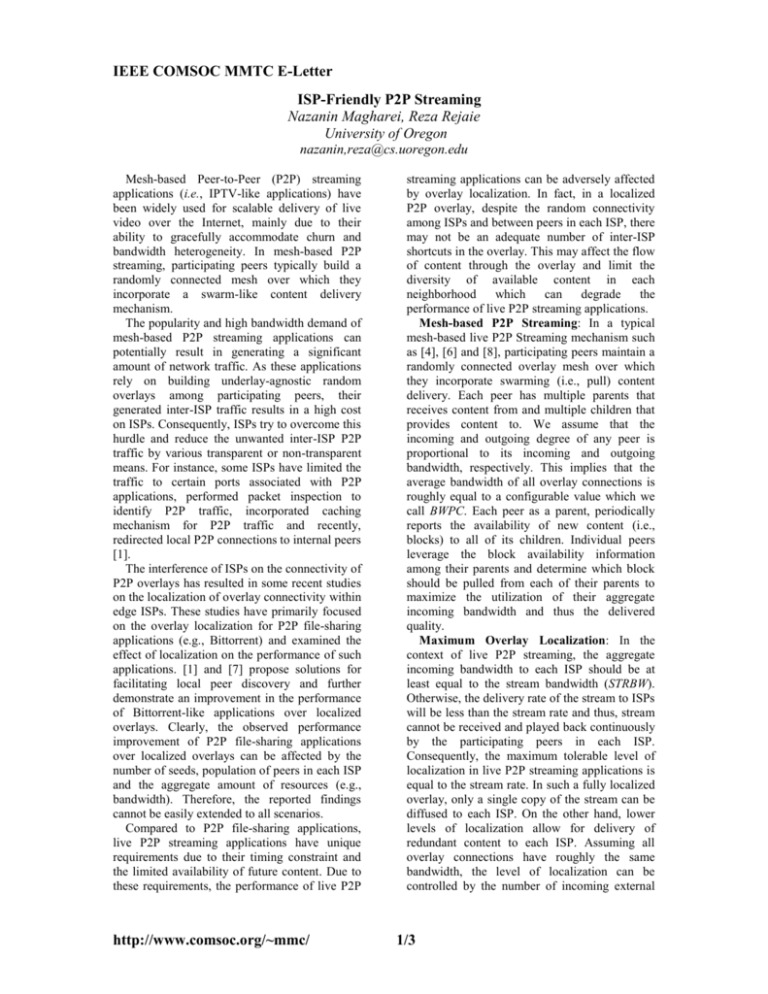
IEEE COMSOC MMTC E-Letter ISP-Friendly P2P Streaming Nazanin Magharei, Reza Rejaie University of Oregon nazanin,reza@cs.uoregon.edu Mesh-based Peer-to-Peer (P2P) streaming applications (i.e., IPTV-like applications) have been widely used for scalable delivery of live video over the Internet, mainly due to their ability to gracefully accommodate churn and bandwidth heterogeneity. In mesh-based P2P streaming, participating peers typically build a randomly connected mesh over which they incorporate a swarm-like content delivery mechanism. The popularity and high bandwidth demand of mesh-based P2P streaming applications can potentially result in generating a significant amount of network traffic. As these applications rely on building underlay-agnostic random overlays among participating peers, their generated inter-ISP traffic results in a high cost on ISPs. Consequently, ISPs try to overcome this hurdle and reduce the unwanted inter-ISP P2P traffic by various transparent or non-transparent means. For instance, some ISPs have limited the traffic to certain ports associated with P2P applications, performed packet inspection to identify P2P traffic, incorporated caching mechanism for P2P traffic and recently, redirected local P2P connections to internal peers [1]. The interference of ISPs on the connectivity of P2P overlays has resulted in some recent studies on the localization of overlay connectivity within edge ISPs. These studies have primarily focused on the overlay localization for P2P file-sharing applications (e.g., Bittorrent) and examined the effect of localization on the performance of such applications. [1] and [7] propose solutions for facilitating local peer discovery and further demonstrate an improvement in the performance of Bittorrent-like applications over localized overlays. Clearly, the observed performance improvement of P2P file-sharing applications over localized overlays can be affected by the number of seeds, population of peers in each ISP and the aggregate amount of resources (e.g., bandwidth). Therefore, the reported findings cannot be easily extended to all scenarios. Compared to P2P file-sharing applications, live P2P streaming applications have unique requirements due to their timing constraint and the limited availability of future content. Due to these requirements, the performance of live P2P http://www.comsoc.org/~mmc/ streaming applications can be adversely affected by overlay localization. In fact, in a localized P2P overlay, despite the random connectivity among ISPs and between peers in each ISP, there may not be an adequate number of inter-ISP shortcuts in the overlay. This may affect the flow of content through the overlay and limit the diversity of available content in each neighborhood which can degrade the performance of live P2P streaming applications. Mesh-based P2P Streaming: In a typical mesh-based live P2P Streaming mechanism such as [4], [6] and [8], participating peers maintain a randomly connected overlay mesh over which they incorporate swarming (i.e., pull) content delivery. Each peer has multiple parents that receives content from and multiple children that provides content to. We assume that the incoming and outgoing degree of any peer is proportional to its incoming and outgoing bandwidth, respectively. This implies that the average bandwidth of all overlay connections is roughly equal to a configurable value which we call BWPC. Each peer as a parent, periodically reports the availability of new content (i.e., blocks) to all of its children. Individual peers leverage the block availability information among their parents and determine which block should be pulled from each of their parents to maximize the utilization of their aggregate incoming bandwidth and thus the delivered quality. Maximum Overlay Localization: In the context of live P2P streaming, the aggregate incoming bandwidth to each ISP should be at least equal to the stream bandwidth (STRBW). Otherwise, the delivery rate of the stream to ISPs will be less than the stream rate and thus, stream cannot be received and played back continuously by the participating peers in each ISP. Consequently, the maximum tolerable level of localization in live P2P streaming applications is equal to the stream rate. In such a fully localized overlay, only a single copy of the stream can be diffused to each ISP. On the other hand, lower levels of localization allow for delivery of redundant content to each ISP. Assuming all overlay connections have roughly the same bandwidth, the level of localization can be controlled by the number of incoming external 1/3 IEEE COMSOC MMTC E-Letter connections to each ISP. For instance, in the fully localized overlay, the number of incoming external connections to each ISP is set to its minimum value of STRBW . BWPC Effect of Localization: To investigate the effect of localization on the performance of mesh-based live P2P streaming applications, we evaluate the performance of a typical meshbased live P2P streaming mechanism (i.e., PRIME [2], [4]) over overlays with various levels of localization through NS-2 simulations. We consider a homogeneous scenario with 500 peers that are evenly distributed across 10 ISPs. We focus on a resource-constrained setting where the source and peers bandwidth is equal to the stream bandwidth of 700 Kbps. The incoming and outgoing degree of each peer is set to 6 and source has also 6 children. We define the level of localization as the ratio of stream bandwidth to aggregate external incoming bandwidth for each ISP. For instance, in case of 100% localization or fully localized overlay, the aggregate incoming bandwidth to each ISP is equal to the stream bandwidth which implies that the total number of incoming connections to each ISP is 6. Figure 1 depicts the distribution of the percentage of delivered quality to peers for overlays with various levels of localization. The line labeled as ‘Rand‘ shows the delivered quality in a random overlay. Interestingly, this figure illustrates the following important points: (i) In a typical mesh-based P2P streaming mechanism over a fully localized overlay, the delivered quality to all peers significantly decreases. (ii) Decreasing the level of localization (i.e., allowing more redundant traffic to ISPs) gradually improves the overall performance. In fact, to deliver a good quality to a large fraction of peers, the level of localization should be less than 20%. In other words the external incoming bandwidth to each ISP should be at least 5 times of the stream bandwidth. Solution: There are two approaches to tackle the problem of P2P localization in the context of live streaming as follows: (i) Identify the maximum level of localization (minimum amount of external incoming traffic) that enables a typical mesh-based P2P streaming mechanism to provide high quality stream to individual peers by maintaining adequate level of diversity in the overlay. Such a maximum level of localization can be potentially affected by several factors such as the number of ISPs, peer population in each ISP and peers bandwidth. Thus, the key http://www.comsoc.org/~mmc/ Figure 1: Distribution of the delivered quality to individual peers across overlays with various levels of localization and a random overlay. issue in this approach, is to find the maximum level of localization in a dynamic and distributed fashion. (ii) Design an ISP-friendly P2P streaming mechanism that achieves a good performance in fully localized overlays. In such an ISP-friendly mechanism, edge peers of the ISPs (i.e., those peers with an external incoming connection) play a more important role in determining the proper flow of content and should pull fresh and unique blocks of content to their corresponding ISPs. Our research group is investigating both of the above approaches. Further information about these projects is available online at http://mirage.cs.uoregon.edu/PRIME/P2P.html. REFERENCES [1] D. R. Choffnes and F. E. Bustamante, “Taming the torrent: A practical approach to reducing cross-isp traffic in peer-to-peer systems,” in ACM SIGCOMM, 2008. [2] N. Magharei and R. Rejaie, “PRIME: Peerto-Peer Receiver-drIven MEsh-based Streaming,” in IEEE INFOCOM, 2007. [3] N. Magharei and R. Rejaie, “Overlay monitoring and repair in swarm-based peer-topeer streaming,” in ACM NOSSDAV, 2009. [4] N. Magharei and R. Rejaie, “PRIME: Peerto-Peer Receiver-drIven MEsh-based Streaming,” ACM/IEEE Transactions on Networking, 2009. [5] N. Magharei, R. Rejaie, V. Hilt, I. Rimac, and M. Hofmann, “ISP-Friendly Live P2P Streaming,” Tech. Rep. CIS-TR-09-07, 2009. [Online]. Available: http://mirage.cs.uoregon.edu/pub/tr09-07.pdf 2/3 IEEE COMSOC MMTC E-Letter [6] V. Pai, K. Kumar, K. Tamilmani, V. Sambamurthy, and A. Mohr, “Chainsaw: Eliminating Trees from Overlay Multicast,” in IPTPS, 2005. [7] H. Xie, R. Yang, A. Krishnamurthy, Y. Liu, and A. Silberschatz, “P4p: Provider portal for (p2p) applications,” in ACM SIGCOMM, 2008. [8] X. Zhang, J. Liu, B. Li, and T. Yum, “Coolstreaming: A data-driven overlay network for live media streaming,” in IEEE INFOCOM, 2005. Nazanin Magharei is currently a Ph.D. candidate in the Computer Science Department at the University of Oregon. She received her B.S. degree in Electrical Engineering from Sharif University of Technology, Iran in 2002. Her research interests include P2P streaming, P2P overlay characterization and network measurement. http://www.comsoc.org/~mmc/ Reza Rejaie (SM'06/ACM SM'06) received his M.S. and Ph.D. degrees from the University of Southern California in 1996 and 1999, and his B.S. degree from the Sharif University of Technology in 1991. He is currently an Associate Professor at the University of Oregon. From 1999 to 2002, he was a Senior Technical Staff member at AT\&T Labs---Research in Menlo Park, California. His research interests include P2P networking, network measurement and multimedia networking. Reza received a NSF CAREER Award for his work on P2P streaming in 2005. 3/3


